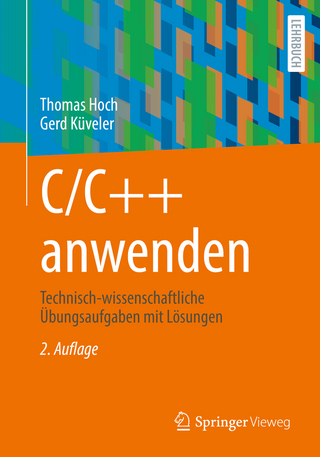
C++ Network Programming, Volume 2
Addison Wesley (Verlag)
978-0-201-79525-7 (ISBN)
- Keine Verlagsinformationen verfügbar
- Artikel merken
Writing high-quality networked applications is difficult - it's expensive, complicated, and error-prone. In order to be successful, software for networked applications must be affordable, extensible, flexible, portable, predictable, efficient, reliable, and scalable. This book picks up where volume one left off, and guides C++ programmers through using the ADAPTIVE Communication Environment (ACE), the most complete toolkit available for networked programming. The first volume focused on problem solving and understanding ACE. This second volume focuses on reuse and frameworks. Both volumes are modeled on Richard Stevens' classic UNIX Network Programming. ACE was invented by Doug Schmidt, and is completely open-source. Steve Huston founded a company which provides support for ACE users, and is at the forefront of the growing ACE community.
Dr. Douglas C. Schmidt is the original developer of ACE and The ACE ORB (TAO). He is a Professor at Vanderbilt University, where he studies patterns, optimizations, middleware, and model-based tools for distributed real-time and embedded systems. He is a former editor-in-chief of C++ Report and columnist for C/C++ Users Journal. Stephen D. Huston is President and CEO of Riverace Corporation, a provider of technical support and consulting services to companies who want to keep software projects on track using ACE. Steve has nearly ten years of experience with ACE, and more than twenty years of software development experience, focusing on network protocol and C++ networked application development in a wide range of hardware and software environments.
(NOTE: Chapters 3-9 begin with an Overview and each chapter concludes with a Summary.)
Foreword.
About This Book.
1 Object-Oriented Frameworks for Network Programming.
An Overview of Object-Oriented Frameworks.
Comparing Software Development and Reuse Techniques.
Applying Frameworks to Network Programming.
A Tour through the ACE Frameworks.
Example: A Networked Logging Service.
2 Service and Configuration Design Dimensions.
Service and Server Design Dimensions.
Configuration Design Dimensions.
3 The ACE Reactor Framework.
The ACE Time Value Class.
The ACE Event Handler Class.
The ACE Timer Queue Classes.
The ACE Reactor Class.
4 ACE Reactor Implementations.
The ACE Select Reactor Class.
The ACE TP Reactor Class.
The ACE WFMO Reactor Class.
5 The ACE Service Configurator Framework.
The ACE Service Object Class.
The ACE Service Repository Classes.
The ACE Service Config Class.
6 The ACE Task Framework.
The ACE Message Queue Class.
The ACE Task Class.
7 The ACE Acceptor-Connector Framework.
The ACE Svc Handler Class.
The ACE Acceptor Class.
The ACE Connector Class.
8 The ACE Proactor Framework.
The Asynchronous I/O Factory Classes.
The ACE Handler Class.
The Proactive Acceptor-Connector Classes.
The ACE Proactor Class.
9 The ACE Streams Framework.
The ACE Module Class.
The ACE Stream Class.
Glossary.
Bibliography.
Index. 0201795256T11042002
| Erscheint lt. Verlag | 8.11.2002 |
|---|---|
| Reihe/Serie | The C++ In Depth Series |
| Mitarbeit |
Herausgeber (Serie): JOHN FULLER |
| Verlagsort | Harlow |
| Sprache | englisch |
| Maße | 186 x 234 mm |
| Gewicht | 590 g |
| Themenwelt | Informatik ► Programmiersprachen / -werkzeuge ► C / C++ |
| ISBN-10 | 0-201-79525-6 / 0201795256 |
| ISBN-13 | 978-0-201-79525-7 / 9780201795257 |
| Zustand | Neuware |
| Haben Sie eine Frage zum Produkt? |
aus dem Bereich


